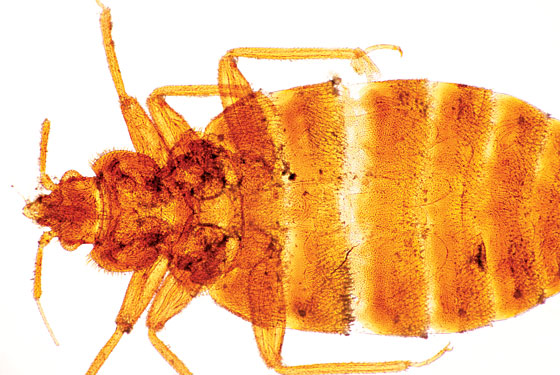
Believed eradicated in the U.S. by DDT in the forties and fifties, bedbugs started reappearing in the late eighties, reaching epidemic levels in the past decade. Exterminators, unprepared to deal with a pest unseen for years, can’t rely on DDT because it’s been illegal since 1972. While pest-control companies get up to speed on treatment options and the general public gradually learns how bedbugs spread, the proliferation continues.
HOW TO PREVENT THEM
Exterminators universally recommend against buying used mattresses or taking any furniture off the street—ever—and advise extreme judiciousness about purchases from Craigslist and the like. That includes every kind of furniture: Bedbugs will hide and lay eggs in almost any material. Sofas, dressers, frames, and lamps all can be contaminated; the bugs have a special predilection for the tiny nooks and imperfections in fabric and wood. (Exterminator Mark Hill advises against buying used wooden headboards.) Examine used furniture thoroughly for tiny spots of dried blood and fecal matter, which looks like poppy seeds. Spray seams and cracks of any used-furniture purchases with Steri-Fab (available at the Bug Off Pest Control Center in Washington Heights). Steri-Fab kills bedbugs but not their hard-to-see eggs, which are about 1 mm. in diameter. There’s some debate about whether any product can kill eggs.
When traveling, keep your luggage off the ground, away from beds. Spray hotel headboards with Steri-Fab. Check your bags for any signs of bugs when you get home: Adults are around 4 to 5 mm. long, with flat bodies the size and color of apple seeds. Seal your clothes in a plastic bag and launder them before returning them to your dresser; you might even want to consider getting luggage you can throw directly in the laundry (e.g., duffel bags).
HOW TO TELL IF YOU HAVE THEM
Bedbugs don’t eat food like roaches or rodents do; they eat blood. The telltale signs of their presence are itchy welts on your body, frequently in clusters of three or more. You might see tiny red or brown marks on your sheets where you’ve crushed bugs in the night. If you suspect infestation, check under carpets and in moldings, and survey mattresses, box springs, and bed frames. Look for feces and shed skins. And look for nymphs: “Ninety-nine percent of papers written on bedbugs neglect to mention that a bedbug starts as a tiny egg and hatches from it to become a [1- to 1.6-mm.] nymph that’s translucent white,” says Louis Sorkin, entomologist at the American Museum of Natural History. “If people knew to look for nymphs, they could head off the problem much sooner.” The bugs pass through six stages of development and feed at least once during each, which means you can get bites before there are full-grown adults visible. If you think you have a problem but can’t find anything, press packing tape or a lint roller underneath carpet and in the corners of beds. Nymphs and eggs will stick to it.

WHAT TO DO IF YOU’VE GOT THEM
Admit you have a problem, but don’t overreact. Let neighbors know that there are bugs around. Tell the dry cleaner if you have anything potentially contaminated (dry cleaning should kill bugs and eggs). If you throw out furniture, label it infested. Don’t terrify yourself with horror stories on the Internet; check informative sites like Bedbugger.com. And don’t strike wantonly with Raid or random drugstore foggers/bombs—the bugs will just wait out the blitz in your apartment or a neighbor’s.

DO WHAT YOU CAN, THEN CALL THE PROFESSIONALS.
Seal all your fabric in a bag ASAP, then nuke it. Wash cycles kill bugs (hot water is best), and 30 minutes-plus in a dryer on high kills eggs. Vacuum your room, seal the vacuum bag in another bag, and throw it away. Then call an exterminator. Treatments take an hour and a half (plus four hours to dry), and you’ll usually require more than one visit (cost: about $450). And get zipcovers for your mattress and box spring. (Try Protect-a-Bed or National Allergy Supply’s BedCare.)
SEE SOMETHING (DISGUSTING), SAY SOMETHING
Last week, bedbugged tenants mounted a Craigslist-based attack on their Greenpoint building, and protesters in front of the Department of Health demanded action on asthma-exacerbating roaches and rats. They’re not the only ones who think the city could do more to crush creeping menaces. “Bedbugs are a major mental-health issue. I get tired of the Department of Health saying, ‘It’s not a physical issue, so we’re not going to focus on it,’” says Upper West Side council member Gale Brewer. She (and many exterminators) advocate a campaign along the lines of the subway-safety ads to spread word about bug-suppressing preventive steps. Other strategies: certification of bedbug-specialist exterminators and bans on mattress resales. To fight other pests, exterminators would like the DOH to enforce pre-demolition extermination laws more aggressively and hire more pest-control experts to manage parks and public spaces. For its part, the DOH says it has retrained staff after the KFC/Taco Bell rat debacle and is working on plans to combat residential bedbug and rodent problems.
SEE ALSO:
• Killing Cockroaches
• Eradicating Mice or Rats
• Meet the Experts